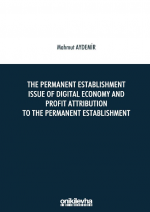 Deriving income from the customers in a state without any physical presence in the state is the main feature that distinguishes digitalised businesses from the traditional businesses. It is a well-known fact that under the current traditional taxation rules, the business income of a non-resident enterprise would be taxable only the state in which enterprise is resident, unless it has a PE in the market state. In a case where the non-resident enterprise has a PE in the market state, then only income that is derived from that PE and it is attributable to it would be taxable in the market state. However, the traditional PE definition is entirely based on a taxable physical nexus which does not allow it to catch the income derived (i) from a country without any physical presence and (ii) from innovation new concept of value creation. This situation has triggered a political and academic discussion about how international taxation can be reformed to provide a "reasonable and stable system for taxing profits of MNEs in the 21st century".
Policymakers in all levels are currently struggling to find sustainable solutions which can ensure effective and fair taxation for taxpayers and tax authorities. In this regard, while some states have already taken some measures to tax the provision of some sort of digital services and goods by implementation Digital Service Taxes unilaterally, creating a new nexus ( Digital PE), allocating taxing right based on value creation and rethinking of profit allocation methods are the remain main subjects on the agenda of competent authorities.
Deriving income from the customers in a state without any physical presence in the state is the main feature that distinguishes digitalised businesses from the traditional businesses. It is a well-known fact that under the current traditional taxation rules, the business income of a non-resident enterprise would be taxable only the state in which enterprise is resident, unless it has a PE in the market state. In a case where the non-resident enterprise has a PE in the market state, then only income that is derived from that PE and it is attributable to it would be taxable in the market state. However, the traditional PE definition is entirely based on a taxable physical nexus which does not allow it to catch the income derived (i) from a country without any physical presence and (ii) from innovation new concept of value creation. This situation has triggered a political and academic discussion about how international taxation can be reformed to provide a "reasonable and stable system for taxing profits of MNEs in the 21st century".
Policymakers in all levels are currently struggling to find sustainable solutions which can ensure effective and fair taxation for taxpayers and tax authorities. In this regard, while some states have already taken some measures to tax the provision of some sort of digital services and goods by implementation Digital Service Taxes unilaterally, creating a new nexus ( Digital PE), allocating taxing right based on value creation and rethinking of profit allocation methods are the remain main subjects on the agenda of competent authorities.
TABLE OF CONTENTS
INTRODUCTION
CHAPTER 1
THE TRADITIONAL PERMANENT ESTABLISHMENT
1.1. Introduction
1.2. Physical PE
1.3. Agency PE
1.4. Service PE
1.5. Preparatory or Auxiliary Activities
1.6. Anti-fragmentation Provision
1.7. Interim Conclusion
CHAPTER 2
DIGITAL PERMANENT ESTABLISHMENT
2.1. Introduction
2.2. Multilateral Measures
2.3. Unilateral Measures
2.4. Interim Conclusion
CHAPTER 3
VALUE CREATION IN THE DIGITAL ECONOMY
3.1. Introduction
3.2. Definition of Value Creation
3.3. Digital B2C Business Model as an Example
3.4. Theoretical Frameworks for Value Creation
3.5. Interim Conclusion
CHAPTER 4
DISCUSSED PROFIT ALLOCATION METHODS: THE WAYS TO ALLOCATE INCOME TO DPE
4.1. Introduction
4.2. The Authorized OECD Approach
4.3. New Proposals for Profit Allocation Methods
4.4. Profit Allocation Methods Discussed in Academy
4.5. Interim Conclusion
CONCLUSION
REFERENCES
